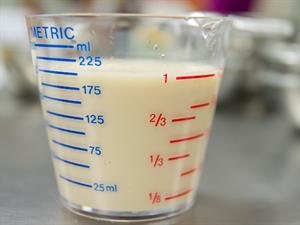
PUMPA - SMART LEARNING
எங்கள் ஆசிரியர்களுடன் 1-ஆன்-1 ஆலோசனை நேரத்தைப் பெறுங்கள். டாப்பர் ஆவதற்கு நாங்கள் பயிற்சி அளிப்போம்
Book Free DemoLiquids do not have any definite shape. But, it takes the form or shape of the container they are stored in. So, even though liquids have volume, they cannot be easily determined, like solids.
Measuring tools
A liquid may be poured into a graduated container to determine its exact volume easily. There are various measuring tools to find the volume of a liquid. Some of them are,
Measuring cylinder
Beakers
The capacity of these containers is determined by the maximum volume of liquid it holds.

Graduated beaker
A liquid's volume is equal to the amount of space it takes up in the container. Therefore, the readings marked in the measuring containers directly shows the liquid's volume.
Unit for measurement
A litre (l) is a unit of measurement used to express the volume of liquid. For example, 1\ - litre milk packet, 20\ litres water can and so on. Other units are millilitre (ml), centilitre (cl), and kilolitre (kl).
The readings in the measuring beakers are usually marked in the unit of a millilitre (ml). In terms of a millilitre,
1\ cl = 10\ ml
1\ l = 100\ cl
1000\ ml = 1\ l
Important!
Some other units of volume to measure the liquids are,
1\ gallon = 3785\ ml
1\ ounce = 30\ ml
1\ quart = 1\ l
Comparison with the units of length
Generally, if the object's dimensions are given in cm, then the unit of volume is written as a cubic\ cm or cc.
One litre (l) is equal to the volume of 1000\ cc.
1\ l = 1000\ cc (or) cm^3
Liquids can be measured in litres and can also be expressed in cubic metre or m^3.